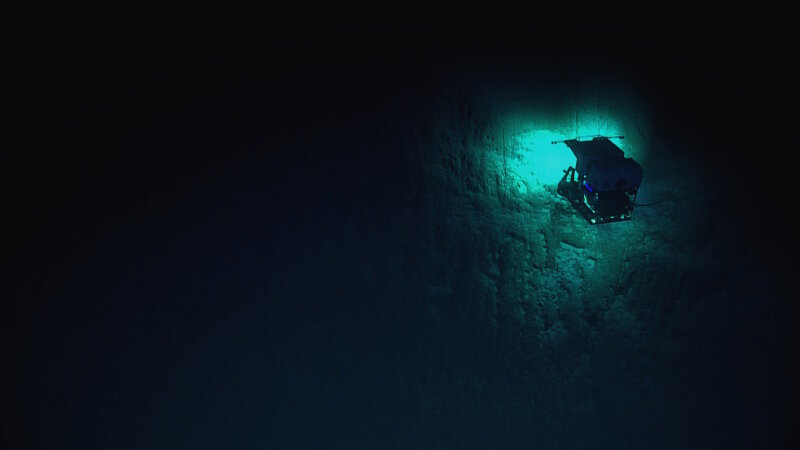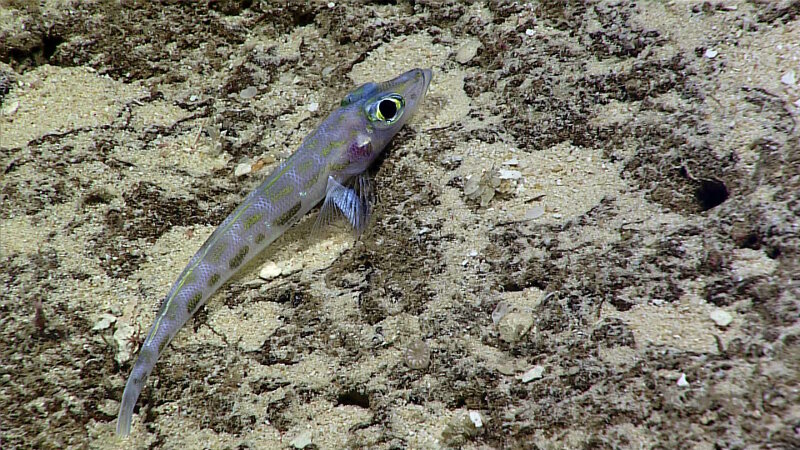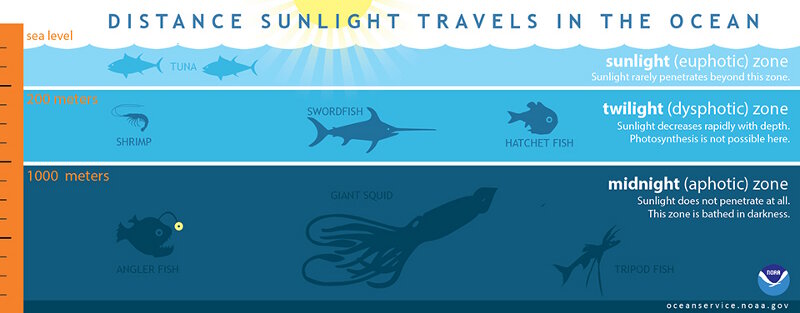
By Scott C. France, University of Louisiana at Lafayette
April 28, 2017

Sunlight does not penetrate the deep sea. Remotely operated vehicles Deep Discoverer (pictured here, at ~360 meters depth at the Aunuʻu Unit of National Marine Sanctuary of American Samoa) and Seirios have multiple lights – over 40 lights between the two robots – that allow researchers to see in the deep ocean. Image courtesy of the NOAA Office of Ocean Exploration and Research, Mountains in the Deep: Exploring the Central Pacific Basin. Download larger version (jpg, 329 KB).
You often hear us say we are exploring the deep sea, but you may not have heard us explicitly define what part of the ocean is considered the "deep sea."
Does it simply mean that we are far from shore? No – on this expedition there will be occasions where we can see land from the deck of the ship while the remotely operated vehicle is exploring hundreds of meters below the surface. Does the "deep sea" mean we are deeper than a specific depth? Some textbooks define the deep sea as ocean depths deeper than 200 meters. But what is special about this depth?

This duckbill fish (family Percophidae) was found at approximately ~275 meters depth. The golden-yellow spots identify the fish as potentially Chrionema chryseres. Its large eyes suggest that it is a visual predator. At these depths, light is scarce, so animals like this fish have developed special visual adaptations to make out their prey in the dim, downwelling light. One common adaptation is large eyes. As the size of the eye increases, the size of the retina, the light receptor, also increases, resulting in a more light-sensitive eye. The more efficient a visual predator's eye becomes, the more successful it will be at hunting in this twilight zone. Image courtesy of the NOAA Office of Ocean Exploration and Research, Mountains in the Deep: Exploring the Central Pacific Basin. Download larger version (jpg, 1.7 MB).
By 200 meters depth, there is no longer enough sunlight available to phytoplankton, or any plant-like organism, for photosynthesis (the process these organisms use to convert the sun’s energy into food – organic molecules). Water, and the particles suspended in the water, absorb and reflect light.

The ocean is divided into three zones based on depth and light level. Although some sea creatures depend on light to live, others can do without it. Image courtesy of NOAA's National Ocean Service. Download larger version (jpg, 205 KB).
Eventually all of the light entering the ocean at the surface is extinguished. Therefore, the deep sea can be defined as lacking sunlight. Because there is no sunlight, there is no photosynthesis, which is where most food on the planet and in the ocean ultimately comes from. Thus, the deep sea is food poor: most of the food available to its inhabitants is what is left over and sinking from the sunlit shallow waters (the exception is at hydrothermal vents and related ecosystems where energy is derived from special molecules rather than the sun).
Sunlight doesn't just provide the energy for photosynthesis: it heats the water. The ocean surface near the equator is the hottest because it receives the most continuous direct sunlight. The deeper into the ocean you descend, the less sunlight there is. This results in less warming of the water. Therefore, the deep ocean is cold – with an average temperature of only 4°C. Cold water is also more dense, and as a result heavier, than warm water. Older water sinks below the warm water at the surface, which contributes to the coldness of the deep ocean.
This means the deep sea is the part of our ocean that is dark, cold, food-poor, and typically deeper than 200 meters. Coincidentally, that depth is also a good approximation of the average depth of the edge of the continental shelf (the portion of a large continental landmass that dips below water – the submerged coastlines). Go beyond the continental shelf and the steepness of the slope increases dramatically, plunging more rapidly into the cold, dark, deep sea.